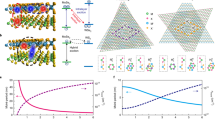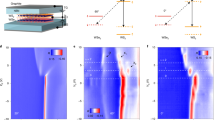Abstract
Moiré superlattices provide a powerful way to engineer the properties of electrons and excitons in two-dimensional van der Waals heterostructures1,2,3,4,5,6,7,8. The moiré effect can be especially strong for interlayer excitons, where electrons and holes reside in different layers and can be addressed separately. In particular, it was recently proposed that the moiré superlattice potential not only localizes interlayer exciton states at different superlattice positions, but also hosts an emerging moiré quasi-angular momentum (QAM) that periodically switches the optical selection rules for interlayer excitons at different moiré sites9,10. Here, we report the observation of multiple interlayer exciton states coexisting in a WSe2/WS2 moiré superlattice and unambiguously determine their spin, valley and moiré QAM through novel resonant optical pump–probe spectroscopy and photoluminescence excitation spectroscopy. We demonstrate that interlayer excitons localized at different moiré sites can exhibit opposite optical selection rules due to the spatially varying moiré QAM. Our observation reveals new opportunities to engineer interlayer exciton states and valley physics with moiré superlattices for optoelectronic and valleytronic applications.
This is a preview of subscription content, access via your institution
Access options
Access Nature and 54 other Nature Portfolio journals
Get Nature+, our best-value online-access subscription
$29.99 / 30 days
cancel any time
Subscribe to this journal
Receive 12 print issues and online access
$209.00 per year
only $17.42 per issue
Buy this article
- Purchase on Springer Link
- Instant access to full article PDF
Prices may be subject to local taxes which are calculated during checkout



Similar content being viewed by others
Data availability
The data that support the findings of this study are available from the corresponding author upon reasonable request.
References
Cao, Y. et al. Unconventional superconductivity in magic-angle graphene superlattices. Nature 556, 43–50 (2018).
Cao, Y. et al. Correlated insulator behaviour at half-filling in magic-angle graphene superlattices. Nature 556, 80–84 (2018).
Chen, G. R. et al. Evidence of a gate-tunable Mott insulator in a trilayer graphene moire superlattice. Nat. Phys. 15, 237–241 (2019).
Spanton, E. M. et al. Observation of fractional Chern insulators in a van der Waals heterostructure. Science 360, 62–66 (2018).
Wallbank, J. R., Patel, A. A., Mucha-Kruczynski, M., Geim, A. K. & Falko, V. I. Generic miniband structure of graphene on a hexagonal substrate. Phys. Rev. B 87, 245408 (2013).
Song, J. C. W., Samutpraphoot, P. & Levitov, L. S. Topological Bloch bands in graphene superlattices. Proc. Natl Acad. Sci. USA 112, 10879–10883 (2015).
Gorbachev, R. V. et al. Detecting topological currents in graphene superlattices. Science 346, 448–451 (2014).
Lee, M. et al. Ballistic miniband conduction in a graphene superlattice. Science 353, 1526–1529 (2016).
Yu, H. Y., Liu, G. B., Tang, J. J., Xu, X. D. & Yao, W. Moiré excitons: from programmable quantum emitter arrays to spin–orbit-coupled artificial lattices. Sci. Adv. 3, e1701696 (2017).
Wu, F. C., Lovorn, T. & MacDonald, A. H. Theory of optical absorption by interlayer excitons in transition metal dichalcogenide heterobilayers. Phys. Rev. B 97, 035306 (2018).
Rivera, P. et al. Observation of long-lived interlayer excitons in monolayer MoSe2–WSe2 heterostructures. Nat. Commun. 6, 6242 (2015).
Latini, S., Winther, K. T., Olsen, T. & Thygesen, K. S. Interlayer excitons and band alignment in MoS2/hBN/WSe2 van der Waals heterostructures. Nano Lett. 17, 938–945 (2017).
Hsu, W. T. et al. Negative circular polarization emissions from WSe2/MoSe2 commensurate heterobilayers. Nat. Commun. 9, 1356 (2018).
Hanbicki, A. T. et al. Double indirect interlayer exciton in a MoSe2/WSe2 van der Waals heterostructure. ACS Nano 12, 4719–4726 (2018).
Tran, K. et al. Evidence for moiré excitons in van der Waals heterostructures. Nature 567, 71–75 (2019).
Seyler, K. L. et al. Signatures of moiré-trapped valley excitons in MoSe2/WSe2 heterobilayers. Nature 567, 66–70 (2019).
Ciarrocchi, A. et al. Polarization switching and electrical control of interlayer excitons in two-dimensional van der Waals heterostructures. Nat. Photon. 13, 131–136 (2019).
Ross, J. S. et al. Interlayer exciton optoelectronics in a 2D heterostructure p–n junction. Nano Lett. 17, 638–643 (2017).
Gillen, R. & Maultzsch, J. Interlayer excitons in MoSe2/WSe2 heterostructures from first principles. Phys. Rev. B 97, 165306 (2018).
Jin, C. H. et al. Observation of moire excitons in WSe2/WS2 heterostructure superlattices. Nature 567, 76–80 (2019).
Wu, F. C., Lovorn, T. & MacDonald, A. H. Topological exciton bands in moire heterojunctions. Phys. Rev. Lett. 118, 147401 (2017).
Zhang, N. et al. Moiré intralayer excitons in a MoSe2/MoS2 heterostructure. Nano Lett. 18, 7651–7657 (2018).
Cao, T. et al. Valley-selective circular dichroism of monolayer molybdenum disulphide. Nat. Commun. 3, 887 (2012).
Mak, K. F., He, K., Shan, J. & Heinz, T. F. Control of valley polarization in monolayer MoS2 by optical helicity. Nat. Nanotechnol. 7, 494–498 (2012).
Xiao, D., Liu, G.-B., Feng, W., Xu, X. & Yao, W. Coupled spin and valley physics in monolayers of MoS2 and other group-VI dichalcogenides. Phys. Rev. Lett. 108, 196802 (2012).
Andor, K. et al. k·p theory for two-dimensional transition metal dichalcogenide semiconductors. 2D Mater. 2, 022001 (2015).
Zhang, X.-X., You, Y., Zhao, S. Y. F. & Heinz, T. F. Experimental evidence for dark excitons in monolayer WSe2. Phys. Rev. Lett. 115, 257403 (2015).
Wang, G. et al. In-plane propagation of light in transition metal dichalcogenide monolayers: optical selection rules. Phys. Rev. Lett. 119, 047401 (2017).
Echeverry, J. P., Urbaszek, B., Amand, T., Marie, X. & Gerber, I. C. Splitting between bright and dark excitons in transition metal dichalcogenide monolayers. Phys. Rev. B 93, 121107 (2016).
Zhou, Y. et al. Probing dark excitons in atomically thin semiconductors via near-field coupling to surface plasmon polaritons. Nat. Nanotechnol. 12, 856–860 (2017).
Li, Z. P. et al. Revealing the biexciton and trion-exciton complexes in BN encapsulated WSe2. Nat. Commun. 9, 3719 (2018).
Chen, S. Y., Goldstein, T., Taniguchi, T., Watanabe, K. & Yan, J. Coulomb-bound four- and five-particle intervalley states in an atomically-thin semiconductor. Nat. Commun. 9, 3717 (2018).
Yu, H. Y., Liu, G. B. & Yao, W. Brightened spin–triplet interlayer excitons and optical selection rules in van der Waals heterobilayers. 2D Mater. 5, 035021 (2018).
Wang, L. et al. One-dimensional electrical contact to a two-dimensional material. Science 342, 614–617 (2013).
Acknowledgements
This work was supported primarily by the US Department of Energy, Office of Science, Office of Basic Energy Sciences, Materials Sciences and Engineering Division under contract no. DE-AC02-05-CH11231 (van der Waals heterostructures program, KCWF16). PLE spectroscopy of the heterostructure is supported by the US Army Research Office under MURI award W911NF-17-1-0312. The growth of hBN crystals was supported by the Elemental Strategy Initiative conducted by the MEXT, Japan and JSPS KAKENHI grant no. JP15K21722. S.T. acknowledges support from an NSF DMR 1552220 NSF CAREER award for the growth of WS2 and WSe2 crystals. E.C.R. acknowledges support from the Department of Defense (DoD) through the National Defense Science & Engineering Graduate Fellowship (NDSEG) Program. C.-S.Y. acknowledges support from grant no. 107-2112-M-003-014-MY3 from the Ministry of Science and Technology.
Author information
Authors and Affiliations
Contributions
F.W. and C.J. conceived the research. C.J., E.C.R. and C.-S.Y. built the optical set-up. C.J., E.C.R. and D.W. carried out optical measurements. C.J., F.W. and E.C.R. performed theoretical analysis. E.C.R., D.W., M.I.B.U. and Z.Z. fabricated van der Waals heterostructures. Y.Q., Y.S., S.T., J.C. and A.Z. grew the WSe2 and WS2 crystals. K.W. and T.T. grew the hBN crystals. All authors discussed the results and wrote the manuscript.
Corresponding author
Ethics declarations
Competing interests
The authors declare no competing interests.
Additional information
Peer review information: Nature Physics thanks Paulina Plochocka, Jun Yan and Ziliang Ye for their contribution to the peer review of this work.
Publisher’s note: Springer Nature remains neutral with regard to jurisdictional claims in published maps and institutional affiliations.
Supplementary information
Supplementary Information
Supplementary Figs. 1–4 and refs. 35–38.
Rights and permissions
About this article
Cite this article
Jin, C., Regan, E.C., Wang, D. et al. Identification of spin, valley and moiré quasi-angular momentum of interlayer excitons. Nat. Phys. 15, 1140–1144 (2019). https://doi.org/10.1038/s41567-019-0631-4
Received:
Accepted:
Published:
Issue Date:
DOI: https://doi.org/10.1038/s41567-019-0631-4
This article is cited by
-
Valley-polarized excitonic Mott insulator in WS2/WSe2 moiré superlattice
Nature Physics (2024)
-
Correlation-driven nonequilibrium exciton site transition in a WSe2/WS2 moiré supercell
Nature Communications (2024)
-
Optical and electrical anisotropy regulation engineering of low-dimensional materials toward polarized detection and imaging applications
Rare Metals (2024)
-
Twistronics and moiré excitonic physics in van der Waals heterostructures
Frontiers of Physics (2024)
-
Harmonic to anharmonic tuning of moiré potential leading to unconventional Stark effect and giant dipolar repulsion in WS2/WSe2 heterobilayer
Nature Communications (2023)



